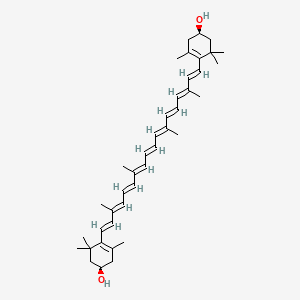Zeaxanthin
Zeaxanthin is a lipid of Prenol Lipids (PR) class. Zeaxanthin is associated with abnormalities such as Disintegration (morphologic abnormality), Alkalemia, Age related macular degeneration, Visual impairment and Consumption-archaic term for TB. The involved functions are known as Signal, Regulation, Energy Transfer, Process and Pigment. Zeaxanthin often locates in Chloroplast thylakoids, reaction center, Tissue membrane, PSII associated light-harvesting complex II and Thylakoid Membrane. The associated genes with Zeaxanthin are PRB2 gene, Structural gene, Polypeptides, Genes, Bacterial and Genes, rRNA. The related lipids are Membrane Lipids, Micelles, Fatty Acids, Lipid Peroxides and monogalactosyldiacylglycerol. The related experimental models are Knock-out.
References related to locations published in Plant Physiol.
| PMID | Journal | Published Date | Author | Title |
|---|---|---|---|---|
| 11891252 | Plant Physiol. | 2002 | Müller-Moulé P et al. | Ascorbate deficiency can limit violaxanthin de-epoxidase activity in vivo. |
| 19011000 | Plant Physiol. | 2009 | Johnson MP et al. | The zeaxanthin-independent and zeaxanthin-dependent qE components of nonphotochemical quenching involve common conformational changes within the photosystem II antenna in Arabidopsis. |
| 17932304 | Plant Physiol. | 2007 | Havaux M et al. | Zeaxanthin has enhanced antioxidant capacity with respect to all other xanthophylls in Arabidopsis leaves and functions independent of binding to PSII antennae. |
| 16183835 | Plant Physiol. | 2005 | Castillo R et al. | Implications of carotenoid biosynthetic genes in apocarotenoid formation during the stigma development of Crocus sativus and its closer relatives. |
| 23966550 | Plant Physiol. | 2013 | Ma G et al. | Enzymatic formation of β-citraurin from β-cryptoxanthin and Zeaxanthin by carotenoid cleavage dioxygenase4 in the flavedo of citrus fruit. |
| 23700351 | Plant Physiol. | 2013 | Kim YK et al. | Functional implication of β-carotene hydroxylases in soybean nodulation. |
| 25501945 | Plant Physiol. | 2015 | Betterle N et al. | High light-dependent phosphorylation of photosystem II inner antenna CP29 in monocots is STN7 independent and enhances nonphotochemical quenching. |
